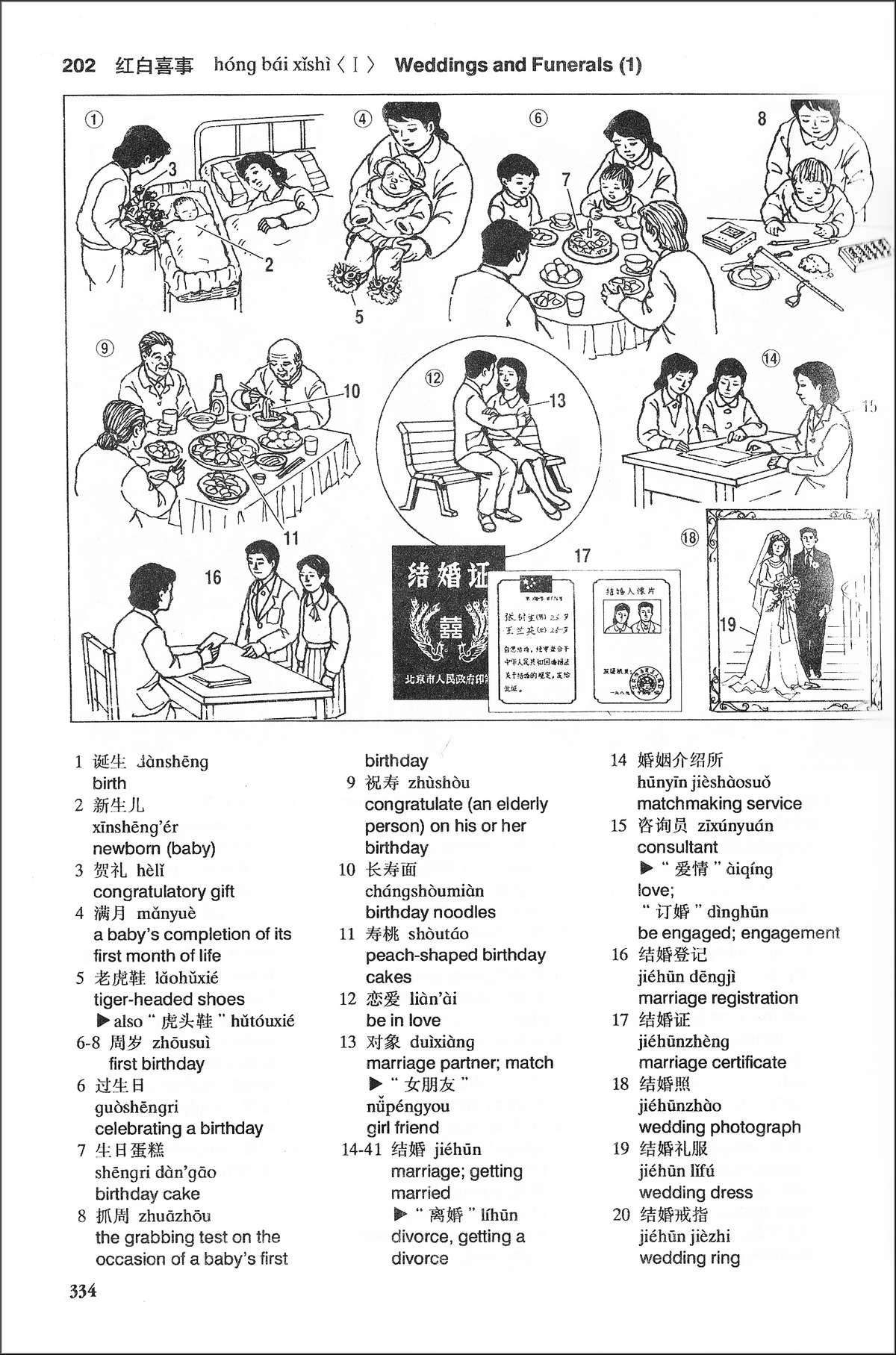 So my son is getting married. In Bejing. To a charming young Chinese woman. And I'm designing the invitations. The first place I turned to for inspiration was my "Longman Chinese-English Visual Dictionary of Chinese Culture," an essential reference tool for anyone visiting the People's Republic. And it's possibly one of the greatest pieces of information design ever done.
So my son is getting married. In Bejing. To a charming young Chinese woman. And I'm designing the invitations. The first place I turned to for inspiration was my "Longman Chinese-English Visual Dictionary of Chinese Culture," an essential reference tool for anyone visiting the People's Republic. And it's possibly one of the greatest pieces of information design ever done.
This 308- or 590-page (depending how you count) book with more than 20,000 entries is crammed with meticulously detailed black-and-white line drawings of Chinese places, people, customs and things, numbered and keyed to the word or description in Mandarin Chinese, in pinyin (phonetic transliteration), and in English.
Although a lot of stuff in major Chinese cities now looks just like it does in Chicago or at the nearby mall (reflective glass office towers, BMWs, KFCs, Pizza Huts, Nike and Apple stores), outside the commercial areas (and even inside them) visual translation is helpful for, as just a few examples: bicycle-carts stacked with charcoal, fried seahorses on skewers, open-crotch toddler overalls. This book shows and tells you about foodstuffs and medicinal herbs, traditional architecture, ethnic minorities and festivals, utensils and tools, train stations, schools, factories and hospitals, public toilets, gardens, markets, restaurants and teahouses ... and just about everything else you'll see in China.
For example, the things on the restaurant wall that look like post-office boxes are wangui, personal lockers for dining utensils. The big container with a spigot is called a chatong, a hot-water urn. Of course, for tea. The game the men in the hutong (alleyway community) are playing is shuzqi (numbered chess). The curved appendage on the corner of a traditional tiled roof is a xiziweir (crest shaped like scorpion tail). The flatbed tricycle for transporting goods is a pingbunche; the streets in the high-tech districts are crammed with young men delivering computer parts on them.
A few things I'd like to learn more about (but don't think I'll experience firsthand) include military installations, nuclear power plants, the kang (heatable brick bed in countryside house), susnchung (bathhouse bed cubicle for resting and toenail-clipping); and xuanminzheng (Communist Party voter's card).
So how about weddings? Pages 202-205 (top numbers) or 334-337 (bottom numbers) are all about hong bui xishi (Weddings and Funerals). There are pictures representing "to be in love," matchmaking service, marriage registration and certificate (I've learned from my son and future daughter-in-law that the actual marriage is a signing at the local Communist Party office), wedding banquet, bridal chamber, festooned vehicle, and honeymoon (dressed-up couple having their picture taken in front of pagoda). On the jiehun qintie (wedding invitation card) drawing I recognize the shuangxi (double happiness) character from all kinds of tourist stuff and the red-and-gold cigarette packs sold on every corner. A Google search for "double happiness Chinese character" leads to a treasure trove of design inspiration, including the following explanation: "Double Happiness is a well-known Chinese character. It is depicted either in paper cut-out or on a red piece of paper, and is affixed in such a position as to easily attract the eyes of young couples."
Is it notable or just a design flaw that on the Wedding page, pictures of newborn babies precede those of weddings? This leads me to the page on Family Planning, and the depiction of the dushengzinuzheng (one-child certificate), something that perhaps American expats don't need to be concerned about. We'll see.
Copyright F+W Media Inc. 2011.
Salon is proud to feature content from Imprint, the fastest-growing design community on the Web. Brought to you by Print magazine, America's oldest and most trusted design voice, Imprint features some of the biggest names in the industry covering visual culture from every angle. Imprint advances and expands the design conversation, providing fresh daily content to the community (and now to Salon.com!), sparking conversation, competition, criticism, and passion among its members.









Shares